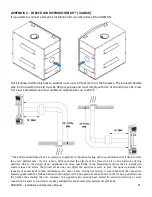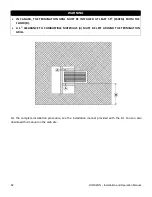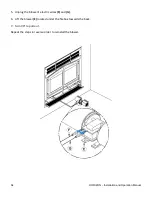
HORIZON – Installation and Operation Manual
49
There are two reasons why the chimney in
the house at right will cold backdraft when
it is cold outside and there is no fire
burning in the fireplace. First, the chimney
runs up the outside of the house, so the air
in it is colder and denser than the warm air
in the house. And second, the chimney is
shorter than the heated space of the
house, meaning the negative pressure low
in the house will pull outside air down the
chimney, through the fireplace and into
the room. Even the finest fireplace will not
work well when connected to this
chimney.
7.5
Chimney installation notes
•
If possible, install an interior chimney as it will provide better performance. In areas with continuous
temperatures below
-
18
°
C (0
°
F), the use of an exterior chimney increases the likelihood of operating
problems such as low draft, high rate of creosoting, and poor start-up characteristics. Exterior chimneys
are also prone to down-drafting and flow reversal. Installations, which are located on lower floors in the
house, such as in a basement, in combination with outside chimney, are especially prone to flow
reversal.
•
The Horizon is listed only with chimney systems described in
TABLE 4 : LISTED CHIMNEYS FOR YOUR
HORIZON.
•
A chimney venting a fireplace shall not vent any other appliance.
•
The minimum chimney system height for a straight installation is 15 ft. (4.6 m).
•
All chimney installations must include at least one support. Reducing the amount of chimney weight on
the fireplace will help avoid the noise created when the fireplace expands. This can be achieved by
having the chimney supported by the supports. The maximum chimney length that should be supported
by the fireplace is 9 ft. (2.75 m) for 2" Solid Pack Chimney and 12 ft. (3.7 m) for 1" Solid Pack Chimney.
•
The chimney must extend at least 3 ft. (92 cm) above its point of contact with the roof and at least 2 ft.
(61 cm) higher than any wall, roof or building within 10 ft. (3.1 m) of it. See the figures on point 11
bellow to determine the configuration that applies to your roof (flat or sloped roof and the distance
between the chimney and the highest point of the roof and/or the nearest chimney).
•
Deviations should be avoided whenever possible, especially the most pronounced. Each deviation adds
some restriction to the chimney system and may lead to draft problems.
•
If the chimney extends higher than 5 ft. (1.5 m) above its point of contact with the roof, it must be
secured using a roof brace.
•
A rain cap must be installed on top of the chimney.
•
Cut and frame square holes in all floors, ceilings, and roof that the chimney will go through to provide a
2" (50 mm) minimum clearance between the chimney and any combustible materials. Do not fill this 2
²
space with insulation or any other combustible material.
•
Portions of the chimney which may extend through accessible spaces must be enclosed to avoid contact
with combustible materials or damage the chimney.
Summary of Contents for HORIZON
Page 10: ...10 HORIZON Installation and Operation Manual 2 3 Measurements ...
Page 11: ...HORIZON Installation and Operation Manual 11 ...
Page 50: ...50 HORIZON Installation and Operation Manual ...
Page 74: ...74 HORIZON Installation and Operation Manual ...
Page 75: ...HORIZON Installation and Operation Manual 75 APPENDIX 9 EXPLODED DIAGRAM AND PARTS LIST ...
Page 80: ...80 HORIZON Installation and Operation Manual ...
















































